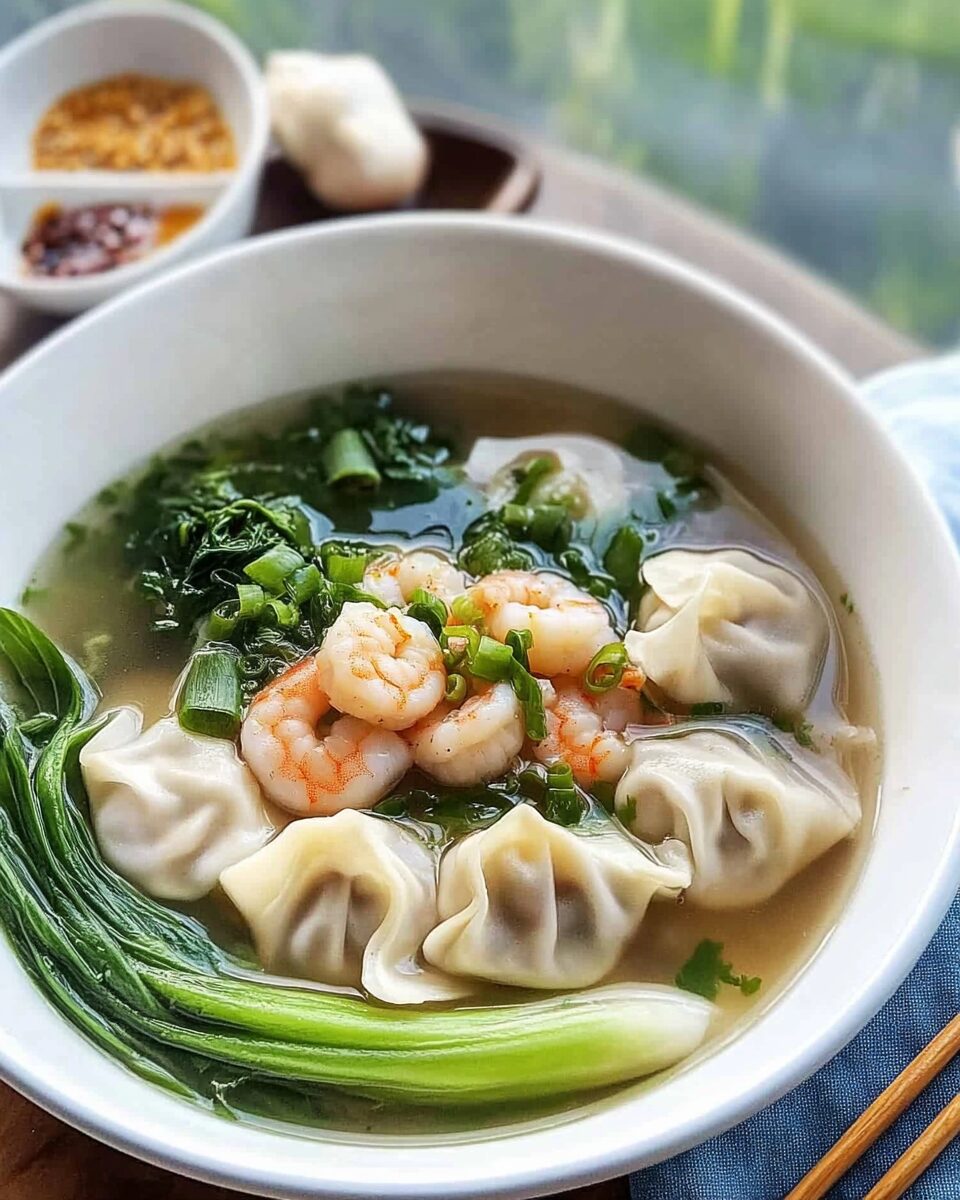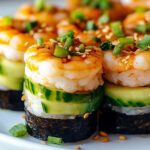The delicate balance of juicy pork and shrimp encased in silky wonton wrappers makes this Wonton Soup a soul-warming comfort dish that’s hard to beat. Infused with fragrant notes of ginger, garlic, soy, and sesame oil, the clear golden broth brings everything together in harmony.
Perfect for cozy nights or when you crave something hearty but light, this soup is deceptively simple yet full of depth. Whether you’re new to homemade dumplings or a seasoned cook, the folding process is quicker than you’d expect—and the rewards are deliciously satisfying. Keep a stash in the freezer, and you’re always 10 minutes away from a restaurant-worthy meal.
Full Recipe:
For the Wontons (makes 50-60):
-
200g (7 oz) lean pork mince (ground pork)
-
200g (7 oz) prawns/shrimp, peeled and roughly chopped
-
1 tbsp fresh ginger, finely grated
-
2 shallots/green onions, finely chopped (approx. 5 tbsp)
-
1 tbsp light soy sauce
-
2 tbsp Chinese cooking wine (Shaoxing wine)
-
½ tsp salt
-
2 tbsp toasted sesame oil
-
50-60 wonton wrappers
For the Broth (2 servings):
-
3 cups (750 ml) chicken broth
-
2 garlic cloves, smashed
-
⅓ inch (1 cm) piece fresh ginger, sliced
-
1½ tbsp light soy sauce
-
2 tsp sugar
-
1½ tbsp Chinese cooking wine
-
¼ – ½ tsp sesame oil
To Serve (optional):
-
Finely chopped scallions
-
Bok choy or Chinese broccoli, quartered or cut into 10cm pieces
-
40 – 50g (1.5 – 1.75 oz) dried egg noodles per person
Directions:
-
Make the Filling:
In a bowl, mash together all wonton filling ingredients using a potato masher until mostly smooth but with some prawn chunks remaining. -
Wrap the Wontons:
Place wonton wrappers on a flat surface. Spoon about 1-1.5 teaspoons of filling onto each. Brush two edges with water, fold into a triangle, press to seal, then bring the two corners together and seal with more water. -
Cook the Wontons:
Bring a large pot of water to boil. Add wontons and cook for 4 minutes or until they float. Remove with slotted spoon. -
Make the Broth:
In a saucepan, combine all broth ingredients. Bring to a simmer for 5-10 minutes. Remove garlic and ginger before serving. -
Blanch Optional Veggies:
Briefly blanch bok choy or Chinese broccoli in the hot broth, then transfer to serving bowls. -
Assemble:
In serving bowls, add cooked wontons, noodles (if using), and veggies. Ladle hot broth over the top. Garnish with scallions.
Prep Time: 20 minutes | Cooking Time: 15 minutes | Total Time: 35 minutes
Kcal: 234 kcal (with veggies, no noodles) | Servings: 4 servings
What Makes Wonton Soup So Special
Wonton Soup holds a revered place in Chinese culinary tradition, often enjoyed as a comforting dish that brings together delicate dumplings, a flavorful broth, and nourishing greens. It’s a staple on Chinese restaurant menus, particularly popular as an appetizer or light meal. What makes it remarkable, especially when homemade, is the purity of the ingredients and the customization potential that store-bought or restaurant versions simply can’t offer.
In this recipe, originally developed by Nagi of RecipeTin Eats with inspiration from Maggie Zhu of Omnivore’s Cookbook, the wontons are filled with a juicy mix of pork and shrimp. The broth, though simple in appearance, is rich in umami and infused with aromatic ingredients like garlic, ginger, and sesame oil. Every bowl feels nourishing and handcrafted, with none of the preservatives or fillers often found in pre-packaged versions.
The Tradition and Versatility of Wontons
The word “wonton” derives from Cantonese, loosely translating to “swallowing clouds”—a poetic description of the way these delicate dumplings float in the broth. Traditionally, wontons are made for Lunar New Year and family gatherings, symbolizing wealth and togetherness. While the exact fillings and wrapping styles vary across Chinese regions, the central concept remains the same: a thin wheat wrapper encasing a seasoned meat or seafood mixture.
Wontons are endlessly versatile. Some variations use ground chicken, shiitake mushrooms, or finely diced vegetables. The wrappers may be twisted differently or pinched into shapes ranging from triangles to flower-like bundles. They can be served in clear soup, deep-fried, or even pan-fried in a style similar to potstickers. But in this version, their home is a clear, aromatic chicken broth that gently complements the richness of the filling.
Mastering the Wonton Wrapping Technique
One of the most rewarding aspects of this recipe is learning to wrap wontons yourself. At first glance, it might look time-consuming or tricky, but with the right method, it becomes a fun and efficient process. This recipe offers two practical approaches: “My Way,” which allows the wrappers to have fluttering tails that mimic noodles once cooked—ideal for soup enjoyment—and “Asian Grocery Store Way,” a more compact fold that’s better for freezing and storing.
Whether you use the first or second method, the goal is always the same: seal the filling well and avoid air pockets to prevent them from bursting during cooking. The wrappers are moistened at the edges to seal, and then the dumplings are shaped either into triangles or a more folded, nested form. Once you’ve done a few, your muscle memory kicks in and the process becomes surprisingly meditative.
The Role of Broth in Elevating the Dish
While the wontons are the visual star, the broth is the unsung hero of this dish. Made with chicken stock, soy sauce, a touch of sugar, garlic, ginger, and Chinese cooking wine, the broth is clear yet layered with savory depth. It’s essential to simmer the broth just long enough to extract flavor from the aromatics without clouding it. Straining the garlic and ginger before serving ensures a clean and elegant presentation.
What sets this broth apart from generic stock is its subtle balance of sweet, salty, and umami-rich notes. The sesame oil added toward the end gives it a lightly toasted aroma, while the cooking wine infuses it with complexity. It serves as the perfect canvas for the juicy wontons and any vegetables you choose to add.
Freezer-Friendly and Meal Prep Approved
One of the biggest advantages of this homemade wonton soup is its freezer-friendliness. Once the wontons are wrapped, they can be frozen raw in airtight containers. When you’re ready to cook them, simply boil from frozen for 6–8 minutes. This makes it incredibly convenient for busy weeknights or unexpected guests.
The ability to freeze these wontons also makes them ideal for meal prepping. Pair a few dumplings with freshly blanched greens and ladle over hot broth for a quick, nutritious meal. It’s far healthier and more satisfying than anything you could pull out of a freezer box, and it avoids the high sodium content of instant noodles or takeout.
Just one cautionary note: if your shrimp was previously frozen, it’s best not to refreeze the raw wontons. You can instead pre-cook the shrimp slightly and then mix it into the pork filling to stay food-safe before freezing.
Customizing the Soup to Your Taste
The core of this recipe is wonderfully adaptable. If you’re not a fan of shrimp, you can replace it with more pork or finely chopped mushrooms for a vegetarian twist. Chinese chives, bamboo shoots, or even grated carrots can add texture and flavor to the filling. You can also spice things up by incorporating chili oil or finely minced chili into the broth.
For those looking to reduce carbs or calories, skip the noodles and increase the greens. Bok choy, Chinese broccoli (gai lan), spinach, or even napa cabbage all work beautifully. If you’re in the mood for a heartier meal, a few strands of egg noodles turn this light soup into a satisfying main course.
Those with dietary restrictions can also adapt the broth easily—use tamari instead of soy sauce for a gluten-free version, or switch to a plant-based broth and tofu filling to make it vegetarian or vegan.
Cultural and Personal Connection
One of the reasons this recipe resonates so deeply with people is because it blends cultural authenticity with modern practicality. Nagi, the creator behind RecipeTin Eats, was inspired by her mother’s traditional recipe but eventually adopted a version by Maggie Zhu that offered even better seasoning and balance. This sort of recipe evolution is what keeps food culture alive—rooted in tradition, but flexible enough to grow.
Making wonton soup from scratch isn’t just about cooking; it’s about experiencing a part of Chinese culinary heritage firsthand. It’s the kind of dish that invites you to slow down, use your hands, and appreciate the process. Whether you’re preparing it for family dinner, storing batches for later, or serving it at a dinner party, it always feels like a special occasion.
Why Homemade Wonton Soup is Worth It
Sure, you can buy frozen wontons or order soup from a takeout menu, but the homemade version offers unmatched flavor and freshness. The texture of the filling, the control over seasoning, and the quality of ingredients are miles ahead of any store-bought version. Plus, the act of wrapping wontons—even imperfectly—is a joyful ritual that connects you with generations of home cooks.
Once you get the hang of it, you’ll never want to go back. You might even find yourself doubling the batch just to have more for the freezer. It’s the kind of kitchen victory that leaves you deeply satisfied—not just because it tastes amazing, but because you made it.
Conclusion
Wonton Soup is more than just a delicious bowl of dumplings and broth—it’s a symbol of comfort, tradition, and culinary joy. This recipe, rich in authenticity and practical in execution, is perfect for both beginner cooks and seasoned foodies looking to expand their repertoire. Whether you’re in it for the deep, fragrant broth, the juicy dumpling centers, or the sheer satisfaction of making it all from scratch, this soup delivers on every level.
It’s a dish that teaches you patience, rewards you with flavor, and invites you to slow down and savor each bite. From the first fold to the last spoonful, homemade Wonton Soup is a heartfelt celebration of everything we love about cooking: warmth, tradition, and sharing something beautiful with the people we care about.





